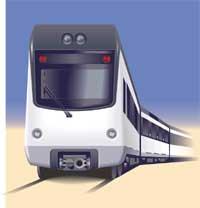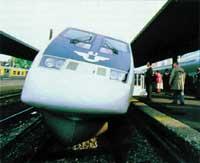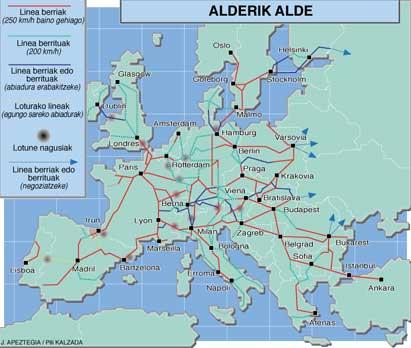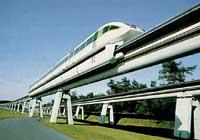European trains before the revolution?
In recent decades the train has been discarded when public transport infrastructure has been designed and the road has been the main one. Among us, in the last 40 years many roads have been closed. However, many experts consider that we are at the door of the train renaissance.
“How
is it said that the man who made the boiling water is precious to always
be
on the hip? I have
no other food if I am well explored by
fire, smoke and chidar, if
I have cold strength.”
“The wisdom of my world
has been very superficial I ask
God, although I will
clarify that before we
did not know that he was
an electrician who now fed on cold waters as
he had before”
European trains before the revolution?

Currently four European states are operating high-speed trains. Although the French TAV is the best known, there are also in Germany, Spain and ltalia, which exceed 250 km/h, which is the threshold of high speed. The European Union plans to extend the high-speed rail network across Europe. Two kilometres of railway per kilometre of motorway are currently being designed in Europe. This was unthinkable a few years ago, as in the 1970s European rail investment reached a minimum.
The plans aim to reach 3,000 km of high-speed track by 998 and 7,400 km of track by the end of the century. The ultimate goal is to organize a 23,000 km high-speed rail network, with a cost of 200,000 euros.
However, the difference between desire and reality can be great. Some of the new roads have serious engineering problems and all are in danger of scarcity of money.
Speed Search

The main current European lines are products of the last century, in which the railway has descended during this century. From the L929 the car appropriated the short distance traffic; from the L960 the plane was made with long distance traffic and the highways have helped drown the train.
Japan opened the high speed road in 1964 when it launched the ‘bullet’ train between Osaka and Tokyo. This train was the first in the world to exceed 160 km/h of average speed. The challenge took seventeen years in Europe when the first stretch of the line between Paris and Lyon opened. Afterwards, Italy came with the line between Florence and Rome. l99ln Germany and Spain entered the high speed club in 1992.
In addition to the aforementioned engineering and economic problems, the European high-speed rail network will have to solve other points. What will be the European train? That is one of the questions, but not the only one. Four serious problems to solve and to some extent facilitate the choice of the railway model: track width, signalling system, electric power supply voltage and tunnel clearance.
The problem comes from the Spanish gauge, which is wider than the rest. The AVE train (High Speed Spain- High Speed Spanish) between Madrid and Seville has standard width, so standardization is resolved. However, some of the Spanish railways, including the Basque Y, will have a variable width so that conventional trains can circulate through it. The distance between the lanes may vary in a fractional way, depending on the characteristics of the train through which it runs.

A signalling and electrical voltage agreement will be required. For all signaling systems, a new one must be made or a state one taken. Currently the system called automatic ATP is being promoted and is wanted to extend to all Europe. Electrical voltage is also variable at the national level. In Spain and France, for example, the power supply voltage of the high-speed train is 25,000 volts and in conventional trains of 3,000 volts and 1,500 volts respectively. In Germany, all trains are 15,000 volts. Therefore, if the same train is going to cross Europe, the question must be unified.
The tunnels generate two problems. When the train enters a tunnel at high speed there are pulses of pressure that damage the ears of passengers. This is avoided by pressurizing trains, like planes, and they have done so in Germany, because trains, for ecological reasons, have to travel a long underground section. On the other hand, the clearance of the British tunnels is smaller than that of the continent, so the continental trains are too large to enter the tunnels. This has a harder repair, since drilling the new tunnels or conditioning the old ones is a huge economic cost.

The French TAV is undoubtedly the best positioned in the European train race. On the one hand, France has the longest high-speed rail network, participates in five international high-speed projects, such as AVE AHT technology, a TAV pressurization project for its passage through Germany Germany and, finally, the hardest competitor of the TAV, Intercity Germany, is too heavy to circulate French high-speed network.
Does the TAV have the only key to transportation on European lanes? Not much less. There are also magnetic levitation trains.
Magnetic levitation, another form of rapid movementThe German Parliament commissioned in 1994 the construction of the train called Transrapid which will link Berlin and Hamburg. The 285 km between the two cities at 10 years will take place in less than an hour with Transrapid which can reach a speed of 420 km/h. At first glance it does not seem much, but it will bring a revolution because he is a magnetic levitation train. In magnetic levitation trains there is no contact between rails and wheels, de facto, since there are no wheels. By means of magnetic forces an air pad is formed between the train and the 10 mm rail in the case of Transrapid. Therefore, magnetic levitation eliminates the energy waste produced by the touch of the rail and wheel. Currently there are two main levitation systems. The Japanese ML 500 takes advantage of the investment force between two poles of the same polarity and reaches a speed of 517 km/h in the experimental railway of Myazaki. Transrapid uses the opposite principle: attraction force between the car electromagnets and the electromagnetic rail. A special length motor gives you thrust and braking force. Magnetic levitation presents two main problems. On the one hand, it needs superconducting threads to create magnetic field, which, at present, while not preparing reliable superconductors at high temperature, requires the use of helium baths, which poses technical and economic challenges. On the other hand, it requests a completely new railway network. Therefore, while in the case of the TAV it is possible to divide the new path to join two points by sections, it is not the case of magnetic levitation, since to join two points it is necessary to build the entire track before circulating the train. |





